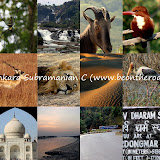Desert national park is located in the Thar Desert in south-west Rajasthan, near the border with Pakistan, spread over Jaisalmer and Barmer districts. The desert national park is an excellent example of the diverse life in the desert habitat.

An area of 3,162 sq km was declared a sanctuary in 1980 to preserve this fascinating and fragile habitat. There are 72 villages within the sanctuary. Some enclosures if barbed wire, with water holes, have been created where the villagers and their cattle are denied access to preserve the grasslands so that they can become wildlife enclaves. Sudashri is the most maintained of these enclaves, and the best place to see the fauna.

I was stationed at Khuri next to the sand dunes and this place was about 14 kms from the Desert National Park. Over 2 days, I went on 3 half day trips to explore the desert national park. I had already purchased my entry tickets while coming from Jaisalmer to Khuri. I would cross 2 beautiful sand dune stretches while riding from my mud house at Khuri to the entrance of the park. A couple of times my motorcycle got stuck, but it added to my excitement. I would park my motorcycle at the forest entrance of the park and along with my forest guide – Mohan Singh, we would explore the desert national park on foot.

As we started our walk into the national park, we spotted an Egyptian vulture basking in the early morning sun. Close ahead, we saw an Eastern Imperial Eagle and a long-billed vulture. It was a great beginning. Soon after, I spotted the rare Chinkara, one of the treasures of this national park.

Chinkara or gazella bennitti, is the smallest Asiatic antelope. It grows to a height of 65 cm and weighs 25 kg. Most males have very short horns, although some grow to a length of 25-30 cm. These gazelles are found in open woodlands and scrublands, which are quite suitable for them to move at high speeds.

I was personally thrilled to see a chinkara gallop in leaps. Their numbers have dwindled to a large extent and they feature on the endangered list. They can go without water for long periods and can even get sufficient fluids from plants and dew drops.

As my forest guide and I continued we spotted more terrestrial birds, the desert fox, the Indian fox and the desert hare.

It was only during my 2nd trip that my forest guide told me to look at the Houbara bustards flying in the distance. In earnest, we began following them. And, instead of spotting the Houbara, we ended up spotting the Great Indian Bustard. There were 4 Great Indian Bustards in the group and each one of them had an elegant look about them. From a distance, I felt like comparing them to 4 men with their chests out and head held high proudly.

The term bustard means slow bird, and in reality, bustards are slow as a consequence of their heavy build. Although they are strong fliers, they usually do not leave the ground. Earlier, bustards were widespread across the Indian subcontinent, but today, this species has all but disappeared from Pakistan and its population in India has reduced considerably. Now classified as endangered, the Great Indian Bustard has become extinct in almost 90 percent of its former range, as a result of loss of habitat and poaching. The Desert National Park was started to save the bustard.
I was extremely lucky during my trip to the Desert National Park or at least that’s what my forest guide told me. In total, I spotted 9 nos of Great Indian Bustard, 8 nos of Houbara Bustard, 1 Desert Fox, 8 nos of Indian Fox, 1 Desert Hare and a large number of chinkara.
In addition, I had witnessed amazing bird life here. Following are the names: White eared bulbul, Egyptian vulture, Houbara bustard, desert wheatear, black-bellied sandgrouse, orphean warbler, great grey shrike, long-billed vulture, eastern imperial eagle, common raven, blue rock pigeon, booted eagle, Great Indian Bustard, House sparrow and brown rock pipit.
To see India through the eyes of a motorcyclist’s lens, visit the album below.
 |
| my solo all-india motorcycle journey |
great
ReplyDeleteThank you Radhakrishnan!
ReplyDeleteVery Well written post, thoroughly enjoyed it. Photos are amazing. Sudashri Forest Pot is really amassing place. You can also check my post at Sudashri Forest Pot Jaisalmer at http://www.touristsafari.com/forests/sudashri-forest-pot-jaisalmer
ReplyDelete